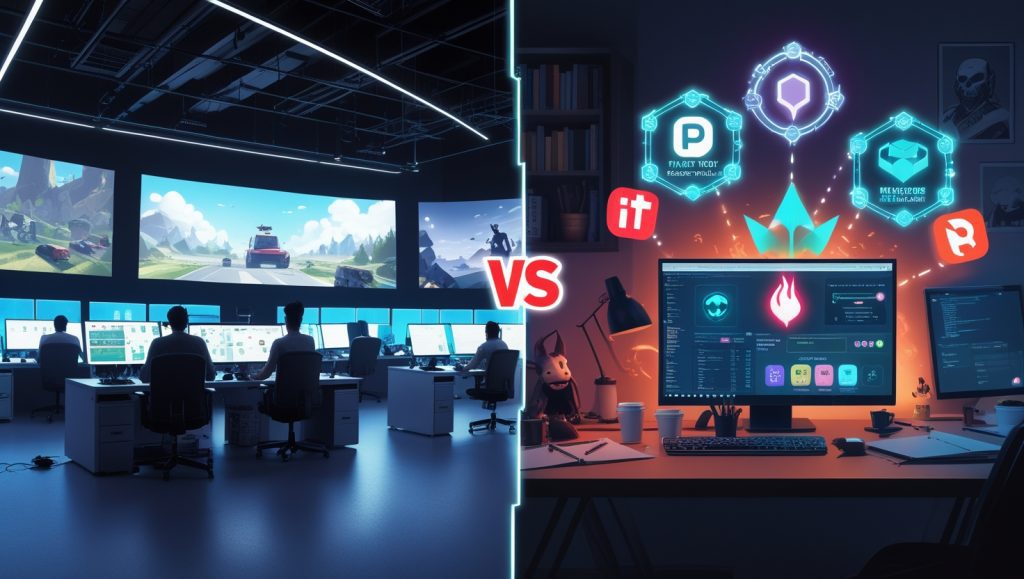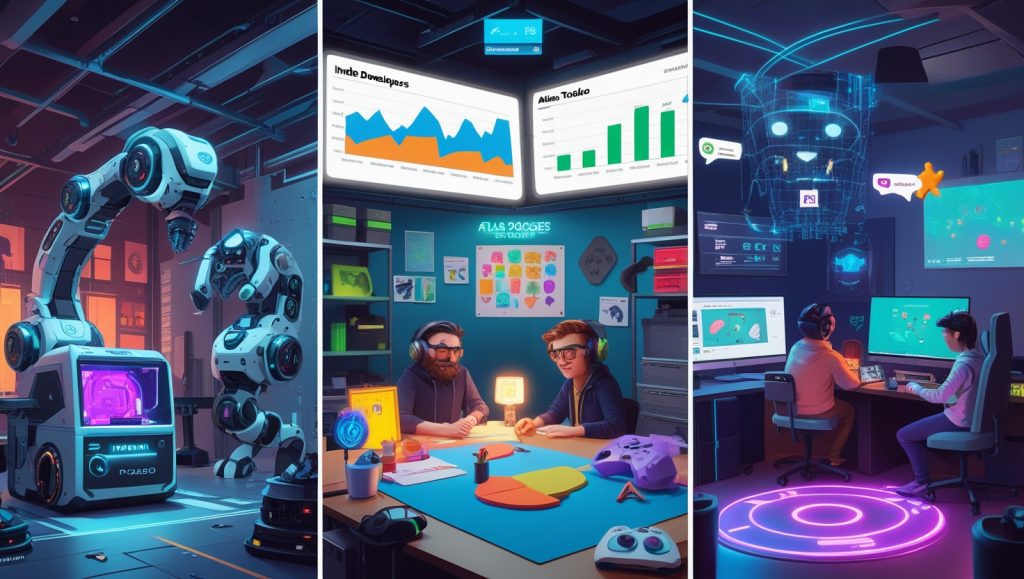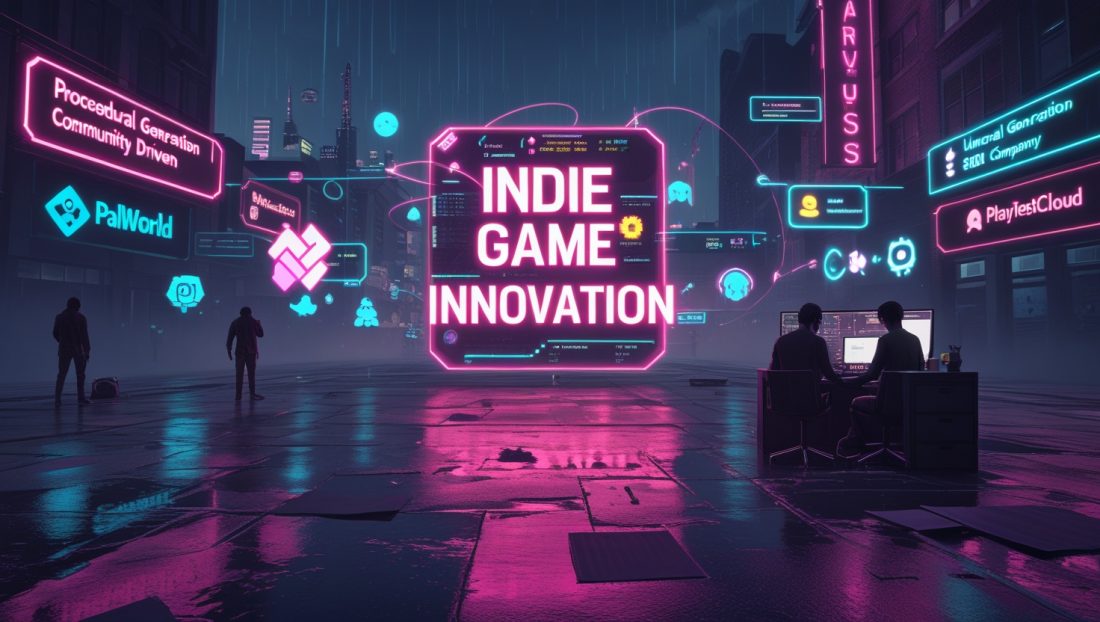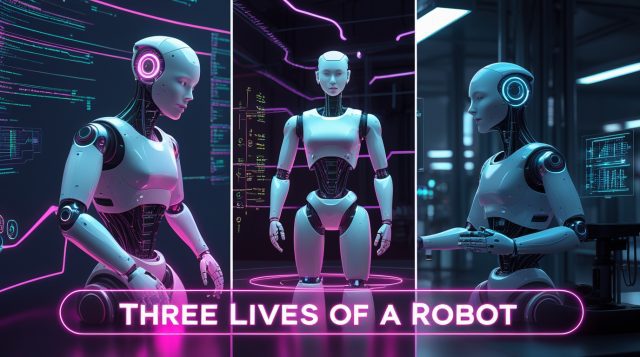Why Are $100K Indies Outselling $100M AAA Games?
When Palworld sold 8 million copies in 6 days with a team smaller than a Starbucks shift crew, it exposed gaming’s power shift. Five of Steam’s 2024 top-grossing titles were indie creations, capturing 31% of platform revenue while AAA studios shuttered divisions after Redfall’s failure. This isn’t luck—it’s a structural revolution driven by indie game innovation. For instance, titles like Lethal Company show how small teams can leverage community feedback to create viral hits, strategy AAA developers are now scrambling to emulate.
The AAA Implosion: Budgets vs. Value

Originality bankruptcy plagues major studios. 2023’s top 10 AAA releases included zero new IPs—only sequels (Spider-Man 2) and remakes (Dead Space). As Tencent’s gaming CFO admitted: “We prioritized monetization pipelines over creative risk. Players noticed.”
Meanwhile, production costs became unsustainable:
- $200M+ budgets require 10M sales just to break even
- $100 game prices test consumer loyalty (GTA VI rumors)
- 38% longer dev cycles than 2018 (Ubisoft earnings call)
Indies thrive by inverting this model. Lethal Company’s solo developer used $45,000 to generate $32 million revenue by focusing on viral gameplay loops rather than 4K textures. This kind of indie game innovation highlights how efficiency and creativity can outpace bloated budgets, lesson AAA studios are learning the hard way.
The Indie Advantage Framework
Democratized Development Tools
Unreal Engine 5’s Nanite technology enables cinematic visuals without AAA resources. Pacific Drive (2024’s surprise hit) achieved its radioactive wasteland aesthetic using:
- AI-assisted asset generation (Midjourney for concept art)
- Procedural level design (Houdini algorithms)
- Cloud-based mocap from $99/month services like Rokoko
“We built our entire enemy roster using AI animation tools. What took Assassin’s Creed six months took us six weeks,” reveals Dreamcore’s lead developer. This democratization fuels indie game innovation, allowing small teams to compete with industry giants. For example, Roblox empowers creators with AI tools to build games rapidly, as seen in how 10 million kids are crafting hits in 2025, showcasing the power of accessible tech.
Indie game innovation thrives because tools like Unreal Engine and AI platforms have lowered barriers to entry. Small studios can now access high-end tech previously reserved for AAA budgets. For instance, GoldenEye 007’s 2025 Hall of Fame induction celebrates how a lean team in the ‘90s created a timeless classic with limited resources, a blueprint indie follow today. Platforms like Unity and Godot further amplify this, offering free or low-cost engines that rival proprietary systems.
According to a GDC 2025 report, 65% of indie developers now use AI-driven tools for at least 30% of their workflow, slashing development time and costs. This efficiency lets indies like Vampire Survivors focus on gameplay over polish, proving that indie game innovation prioritizes player experience over graphical excess.
Hyper-Efficient Production

Indies allocate budgets radically differently:
| Cost Center | AAA Approach | Indie Strategy |
|---|---|---|
| Art Assets | $15M internal team | $20/hr Eastern European freelancers |
| QA Testing | 300-person months | AI bug detection (PlaytestCloud) |
| Marketing | $50M trailers | TikTok organic campaigns |
Vampire Survivors proved this: its $10,000 development cost yielded $200M returns through Steam Early Access iterations. This lean approach is a hallmark of indie game innovation, contrasting sharply with AAA’s bloated pipelines. Games like Blood Strike demonstrate this efficiency, with guides on optimizing gameplay, such as how to drop weapons and ammo during matches, showing how indies prioritize practical player-focused systems over extravagant production.
Indie game innovation extends beyond budgets to workflow ingenuity. Indies often bypass traditional QA with tools like PlaytestCloud, which uses AI to identify bugs 50% faster than human teams, per a Game Developer article. This allows rapid iteration, as seen in Valheim’s modding ecosystem, which extended playtime by 400% through community-driven updates.
Moreover, indies leverage platforms like Itch.io for early feedback, refining games before launch. For example, Hades II’s early access model incorporated player councils, ensuring every patch aligned with fan expectations. This agility lets indies outmaneuver AAA studios, which often spend years on single features, like Call of Duty Mobile’s login systems, which required quick fixes for errors in 2025 due to overcomplex infrastructure.
Community as Co-Creators
Indies treat players as development partners:
- Kickstarter beta keys fund development while building advocates
- Discord-driven patches (Lethal Company added 4 enemies from player sketches)
- Modding-first design (Valheim’s 20,000+ mods extended playtime 400%)
When Palworld incorporated fan-created Pals via Ready Player Me, UGC drove 40% of retention. This community-driven approach is central to indie game innovation, fostering loyalty that AAA titles struggle to replicate. For instance, Fortnite’s metaverse platform shows how community input can ignite engagement, a tactic indies have mastered.
Three Survival Strategies for AAA Studios

Adopt Modular Development
Outsource non-core work:
- AI texture generation (NVIDIA Picasso) cuts asset costs by 70%
- Cross-platform engines eliminate $20M R&D costs
- Third-party QA ecosystems like Keywords Studios
Rockstar spends 8 years building engines. Indies license Unreal for $1,500/year. This shift to modular tools mirrors indie game innovation, enabling AAA studios to streamline without sacrificing quality. Games like Blood Strike highlight this, with guides on optimizing ping settings for lower lag, showing how lean systems enhance player experience.
Launch Micro-Studios
EA’s “Internal Startups” program shows promise:
- 5-person teams with full creative control
- Profit-sharing replacing fixed salaries
- 12-month development caps
Their first project, Atlas Rogues, outsold Battlefield 2042 DLC by 200% despite 1/100th the budget. Micro-studios embody indie game innovation within AAA frameworks, a strategy that could prevent flops like Redfall. The upcoming Nintendo Switch 2, launching in June 2025, also embraces smaller, innovative titles to bolster its lineup, proving the industry is shifting.
Community-First Launches
Replace $50M ad blitzes with:
- Playable prototypes on TikTok/Itch.io
- Player councils guiding design (Hades II)
- Revenue-sharing mod markets (Bethesda’s Creation Club failures)
CD Projekt Red now tests Witcher 4 mechanics via Roblox minigames pre-production. This approach draws from indie game innovation, prioritizing player feedback over marketing hype. PlayStation VR3’s haptic feedback, set to revolutionize immersive gaming this year, also leans on community beta testing to refine its tech, showing AAA’s gradual adoption of indie strategies.
Community-first launches are reshaping how games reach players. Indies like Among Us used Twitch streamers to build hype organically, tactic AAA studios are now mimicking. A Polygon analysis notes that 70% of 2024’s top indie games gained traction through Discord communities before launch, compared to only 15% of AAA titles.
By contrast, AAA’s reliance on expensive trailers often backfires when games underdeliver, as seen with Battlefield 2042. Indies also excel at post-launch support—Blood Strike’s guides on switching meds quickly or enabling third-person parachuting views show how player feedback drives iterative updates, keeping games fresh and relevant.



